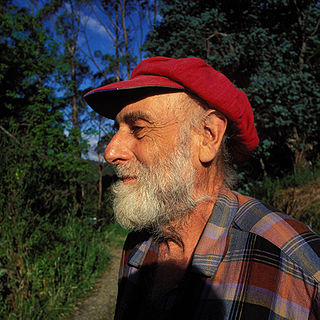
Friedrich Stowasser, better known by his pseudonym Friedensreich Regentag Dunkelbunt Hundertwasser, was an Austrian visual artist and architect who also worked in the field of environmental protection.

Valie Export is an avant-garde Austrian artist. She is best known for provocative public performances and expanded cinema work. Her artistic work also includes video installations, computer animations, photography, sculpture and publications covering contemporary art.
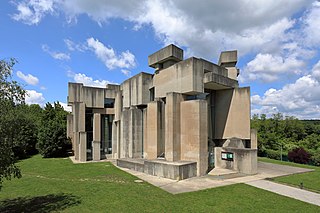
Fritz Wotruba was an Austrian sculptor of Czecho-Hungarian descent. He was considered one of the most notable sculptors of the 20th century in Austria. In his work, he increasingly dissolves figurative components in favor of geometrical abstraction with the shape of the cube as the basic form.
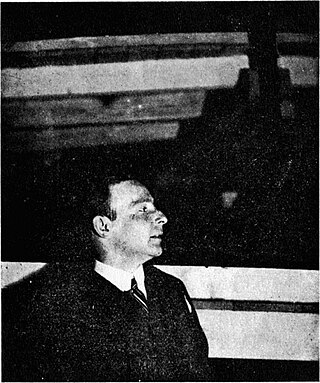
Frederick Jacob Kiesler was an Austrian-American architect, theoretician, theater designer, artist and sculptor.
Muntean/Rosenblum is a collaborative artist duo composed of Markus Muntean and Adi Rosenblum. They have been collaborating since 1992.

Joseph Nigg was an Austrian painter, with painting on porcelain a specialty.
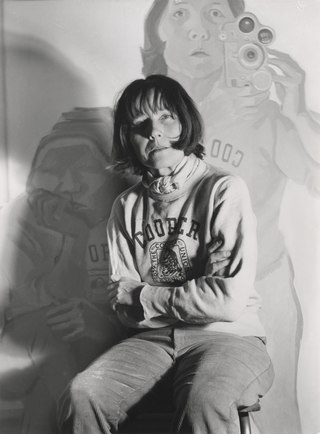
Maria Lassnig was an Austrian artist known for her painted self-portraits and her theory of "body awareness". She was the first female artist to win the Grand Austrian State Prize in 1988 and was awarded the Austrian Decoration for Science and Art in 2005. Lassnig lived and taught in Vienna from 1980 until her death.

Franz West was an Austrian artist.

Josef Danhauser was an Austrian painter and one of the prominent artists of Biedermeier period, along with Ferdinand Georg Waldmüller, Peter Fendi, and others. Danhauser's works, which went largely unappreciated in his time, dealt with moralising subjects and had a clear influence of William Hogarth.

The MAK – Museum of Applied Arts is an arts and crafts museum located at Stubenring 5 in Vienna's 1st district Innere Stadt. Besides its traditional orientation towards arts and crafts and design, the museum especially focuses on architecture and contemporary art. The museum has been at its current location since 1871. Since 2004 the building is illuminated in the evenings by the permanent outdoor installation "MAKlite" of American artist James Turrell. In 2015 the MAK became the first museum to use bitcoin to acquire art, when it purchased the screensaver "Event listeners" of van den Dorpel. With over 300,000 objects displayed online, the MAK presents the largest online collection within the Austrian Federal Museums. The audio guide to this museum is provided as a web-based app.
Sabeth Buchmann is an Austrian art historian and art critic.
The Theodor Körner Prize is a set of annual Austrian awards bestowed by the Theodor Körner Fund in recognition of cultural and/or scientific advances.
Brigitte Kowanz was an Austrian artist. Kowanz studied from 1975 to 1980 at the University of Applied Arts Vienna. She was Professor of Transmedial Art there from 1997.

Rosemarie Schwarzwälder is a gallery owner, art dealer, and journalist. She owns the Galerie nächst St. Stephan in Vienna, Austria, which is known worldwide for its program and participation in international art fairs. Schwarzwälder is interested in more than just presenting artists; she also engages in discussions about current trends in art and how they relate to ancient cultures.

Galerie nächst St. Stephan is an art gallery in Vienna, Austria that was founded by Monseigneur Otto Mauer in 1954 on Grünangergasse next to the Stephansdom, where it is still located today. Rosemarie Schwarzwälder has owned the gallery since 1987. Before that, she was the gallery's director from 1978. Schwarzwälder has made the gallery the international renowned institution that it is today.
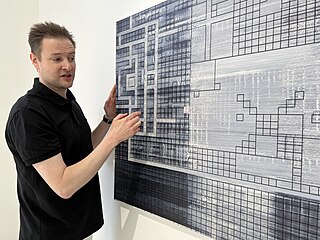
Simon Denny is a contemporary artist based in Berlin. He represented New Zealand at the 2015 Venice Biennale. Since 2018 he is a professor for time based media at the HFBK Hamburg.
Galerie St. Etienne is a New York art gallery specializing in Austrian and German Expressionism, established in Vienna in 1939 by Otto Kallir. In 1923, Kallir founded the Neue Galerie in Vienna. Forced to leave Austria after the 1938 Nazi invasion, Kallir established his gallery in Paris as the Galerie St. Etienne, named after the Neue Galerie's location near Vienna's Cathedral of St. Stephen. In 1939, Kallir and his family left France for the United States, moving the Galerie St. Etienne to New York City. The gallery still exists, run by Otto Kallir's granddaughter Jane at 24 West 57th Street.
Gertie Fröhlich was a Czechoslovak-born Austrian painter, graphic designer and the initiator of the Galerie nächst St. Stephan in Vienna. She was an important figure in the post-war Austrian painting and experimental film world, where often from behind the scenes she supported numerous artists and institutions.

Helmut Leherb was an Austrian artist and representative of the Vienna School of Fantastic Realism, which is close to Surrealism. He was born Helmut Leherbauer in Vienna and is also known as Maître Leherb.

Anna Jermolaewa is a Russia-born conceptual artist based in Vienna, Austria since 1989. Her artistic practice incorporates a wide range of media: video, installation, painting, performance, photography, and sculpture. In 1999, her video work Chicken Triptych was selected by Harald Szeemann to be presented in the Arsenal location of the 48th Venice Biennale. On 16 January 2023, it was announced that Jermolaewa will represent Austria in the 60th Venice Biennale in 2024, exhibiting in the Austrian pavilion in the Giardini della Biennale.















